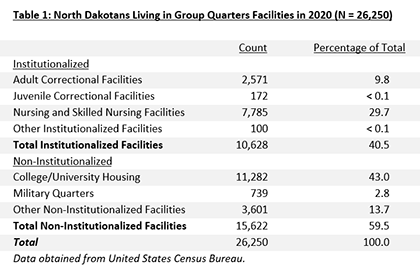Ask A Researcher
October 2022
The Impact of COVID-19 on Group Quarters in North Dakota

Avram Slone, M.A., is a research specialist with the Center for Social Research at North Dakota State University. He has previously worked as a research professional at the Alaska Justice Information Center in Anchorage, Alaska and as a statistical intern at the United States Census Bureau in Suitland, Maryland.The focus of his work at the Center for Social Research is on the disparate impacts of COVID-19 in North Dakota. He received his Master’s Degree in Sociology from the University of Kansas.
Introduction
In 2021, North Dakota State University (NDSU) received a grant from the Centers for Disease Control and Prevention (CDC) to study COVID-19 disparities in underserved populations throughout the state of North Dakota. Since then, the Center for Social Research at NDSU (CSR) has been engaged in several analyses of the impact of COVID-19 on different population groups. One such group is comprised of people living in group quarters (those who live in a group or congregate setting). This group is an integral part of the COVID-19 conversation because of the unique set of challenges posed by COVID-19 in collective living arrangements. In the early days of the pandemic, residents of group quarters were identified as being at high risk for COVID-19 infection because of the relative inability to social distance in settings where persons often have roommates and use shared hygiene, eating, and leisure spaces (Schuetz 2020). This concern is particularly poignant for institutional group quarters such as nursing homes and prisons, which cannot simply close to mitigate or prevent increased risk of outbreak. Long term care facilities are also of particular concern because individuals dwelling in them are likely to be elderly and infirm, and as such may be at increased risk of becoming seriously ill due to COVID-19. Research has shown, elderly persons living in such facilities are markedly more likely to die of COVID-19 once infected than elderly persons living in the community (Axfors & Ioannidis 2022).
Definitions
Despite being an essential group of study in understanding the human impact of the COVID-19 pandemic, residents of group quarters can be a difficult population to contextualize. The primary reason for this is that there are different kinds of group quarters with vastly different population characteristics as well as non-group quarters that may have some congregational aspects, leading to definitional ambiguity. As such, it is necessary to discuss how group quarters are defined and to understand the limitations that this definition places on the analysis of available data.
U.S. Census Bureau Definition
The United States Census Bureau counts residents of group quarters as part of its decennial census. The Census Bureau defines group quarters as “…places where people live or stay in a group living arrangement that is owned or managed by an organization providing housing and/or services for residents (Stempowski 2021).” The Census Bureau also designates group quarters facilities as either institutionalized or non-institutionalized. Examples of institutionalized group quarters facilities include adult and juvenile correctional facilities as well as long term care facilities. Examples of non-institutionalized group quarters facilities include college/university housing and military barracks.
In the 2020 Decennial Census, the United States Census Bureau reported 26,250 residents of group quarters in the state of North Dakota, accounting for roughly 3.5% of the state’s total population of 779,094 – among the highest proportions in the nation. Of residents of group quarters in North Dakota, about 4 in 10 were considered institutionalized and about 6 in 10 were considered non-institutionalized (Table 1).

Data and Methods
The data used in this analysis was provided to the CSR by the North Dakota Department of Health (NDDoH) and includes details of the first COVID-19 infection for North Dakota residents known or suspected to have contracted COVID-19 between March 11th, 2020 and February 13th, 2022. A person is known to have contracted COVID-19 if they received a positive result on a polymerase chain reaction (PCR) test and is suspected to have contracted COVID-19 if they reported a positive result on a rapid antigen test but did not get a PCR test. These data include demographic, geographic, and health variables for each person in the dataset. For the analyses discussed in this article, age, race, and gender variables were included, as were a variable that tagged an individual as either a group quarters resident or non-group quarters resident and an aggregate of the number of common comorbid conditions (medical conditions other than COVID-19) experienced by persons infected with COVID-19. In the interest of simplicity, analyses in this article are limited to descriptive statistics comparing the COVID-19 infected population living in group quarters to the COVID-19 infected population living outside of group quarters.
Findings
COVID-19 Prevalence
During the data collection period (between March 11th, 2020 and February 13th, 2022), NDDoH recorded 223,349 North Dakotans confirmed or suspected to have contracted COVID-19 at least once. Of these, 11,541, or slightly more than 5%, lived in group quarters facilities and 211,808 did not. This means that during the data collection period, an estimated 44% of North Dakotans residing in group quarters contracted COVID-19 at least once, compared to approximately 28% of North Dakotans not residing in group quarters.
The demographic characteristics of individuals infected with COVID-19 residing in group quarters differed from those infected with COVID-19 who were not residing in group quarters, particularly in terms of age. Individuals infected with COVID-19 who resided in group quarters were older than those who did not reside in group quarters (median age of 55 compared to median age of 34, respectively). Infected individuals residing in group quarters were also more likely to be male (52%) than infected individuals not residing in group quarters (48%). The race of persons infected with COVID-19 was similar across living arrangements.
Across living arrangements, about the same proportion of people infected with COVID-19 reported having at least one comorbid condition (19% of those residing in group quarters as well as those not residing in group quarters). Among COVID-19 infected individuals residing in group quarters with at least one comorbid condition, 56% reported more than one comorbidity, compared to only 32% of those not residing in group quarters.
COVID-19 Mortality
During the data collection period, NDDoH recorded 2,121 deaths due to COVID-19. Of these, 1,025 died while residing in a group quarter living arrangement and 1,096 died while residing elsewhere. This means that approximately 9% of group quarters residents infected with COVID-19 died, compared to only 0.5% of non-group quarters residents infected with COVID-19. In different terms, despite accounting for only 5% of confirmed or suspected COVID-19 cases in North Dakota, group quarters residents accounted for 48% of COVID-19 deaths.
As was true of cases, the demographic characteristics of groups quarters residents who died of COVID-19 differed from non-group quarters residents who died of COVID-19. Group quarters residents who died of COVID-19 were older on average than non-group quarters residents who died of COVID-19 (median age of 87 compared to median age of 73). Deaths by sex and race were also substantially different. Group quarters residents who died of COVID-19 were predominantly female (56%) as compared to non-group quarters residents who were predominantly male (66%). Among COVID-19 deaths for which the race of the deceased was recorded, 97% of those who died while resident in group quarters were White, compared to 85% of those who died while not resident in group quarters. The largest difference between living arrangements is seen in the American Indian population, who represented 2% of group quarters deaths and 12% of non-group quarters deaths.
About half of those who died in group quarters reported at least one comorbid condition (48%), while 66% of non-group quarters residents who died of COVID-19 reported at least one comorbid condition. Among those with at least one comorbid condition, those who died while resident in a group quarters facility were still more likely to have multiple reported comorbidities than those who died while not resident in a group quarters facility (72% and 64%, respectively).
Conclusions
COVID-19 has disparately impacted North Dakotans living in group quarters, many of whom are older North Dakotans likely to be resident in long term care facilities. People residing in group quarters are overrepresented in both confirmed case counts and death counts. Death rates due to COVID-19 in group quarters are particularly alarming, with group quarters accounting for nearly half of the North Dakota’s COVID-19 deaths despite accounting for only 5% of confirmed or suspected COVID-19 cases and only 3.5% of the state’s total population. Age was disparate in measuring both COVID-19 prevalence and COVID-19 mortality; group quarters residents who were infected with COVID-19 and/or who died of COVID-19 were older on average than non-group quarters residents who were infected with and/or who died from COVID-19. Group quarters residents who died of COVID-19 were more likely to be female than non-group quarters residents, more likely to be White than non-group quarters residents, and less likely to be American Indian than non-group quarters residents. Interestingly, group quarters residents who died of COVID-19 were less likely to have at least one comorbid condition, but among those who had at least one comorbid condition group quarters residents who were infected with and/or died from COVID-19 were more likely than non-residents to have multiple comorbid conditions.
References
Axfors, C., & Ioannidis, J. P. (2022). Infection fatality rate of COVID-19 in community-dwelling elderly populations. European Journal of Epidemiology, 37(3), 235–249. https://doi.org/10.1007/s10654-022-00853-w
Schuetz, J. (2020, March 12). America's inequitable housing system is completely unprepared for coronavirus. Brookings. Retrieved September 23, 2022, from https://www.brookings.edu/blog/the-avenue/2020/03/12/americas-inequitable-housing-system-is-completely-unprepared-for-coronavirus/
Stempowski, D. (2021, October 8). 2020 Census Group Quarters. The United States Census Bureau. Retrieved September 23, 2022, from https://www.census.gov/newsroom/blogs/random-samplings/2021/03/2020-census-group-quarters.html
